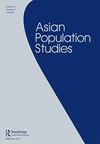语言区的生育行为:重新审视大孟加拉邦的扩散假说
IF 1.5
4区 社会学
Q2 DEMOGRAPHY
引用次数: 3
摘要
摘要本研究比较了西孟加拉邦(印度东部的一个邦)和孟加拉国相邻地区的生育相关行为。这篇论文的出发点是,共同的历史和语言导致了生育实践从西孟加拉邦向孟加拉国的传播。这被认为是为了在两个政治区域的边界地区创造一种同质的生育行为模式。该研究使用了1992年、2002年和2012年的人口健康调查(DHS)和地区级家庭调查数据。尽管有一些保留意见,因为国土安全部被要求产生州级估计,而DLHS则被要求产生地区级估计,但抽样策略和所有地区(西孟加拉邦)和部门(孟加拉国)的覆盖率的相似性意味着这两个数据集可能会被合并,特别是在没有任何替代方案的情况下。我们使用多层次线性和逻辑模型测试了(i)两国边境地区与非边境地区的生育行为是否不同,以及(ii)两国边境区是否相似。结果变量包括避孕普及率和出生儿童数量。研究结果显示,孟加拉国和西孟加拉邦边境地区的生育行为相似,表明生育做法可能在跨境传播。本文章由计算机程序翻译,如有差异,请以英文原文为准。
Fertility behaviour in linguistic zones: revisiting the diffusion hypothesis in greater Bengal
ABSTRACT This study compares fertility-related behaviour in the adjacent regions of West Bengal (a state in eastern India) and Bangladesh. The starting premise of the paper is that common history and language has led to diffusion of fertility practices from West Bengal to Bangladesh. This is hypothesised to create a homogenous pattern of fertility behaviour in the bordering districts of both political regions. The study uses Demographic Health Survey (DHS) and District level Household Survey data for 1992, 2002, and 2012. Despite some reservations – as DHS is directed to produce state-level estimates, while DLHS is geared to yield district-level estimates – the similarity in sampling strategies and coverage of all districts (in West Bengal) and divisions (in Bangladesh) implies that the two data sets may be pooled, particularly in the absence of any alternatives. We tested whether fertility behaviour in (i) bordering districts differs from non-border districts in both countries, and (ii) bordering districts of both countries are similar using multi-level linear and logistic models. Outcome variables are contraceptive prevalence rate, and number of ever born children. The results reveal similarities in fertility behaviour between border divisions of Bangladesh and West Bengal, indicating possible cross-border diffusion of fertility practices.
求助全文
通过发布文献求助,成功后即可免费获取论文全文。
去求助
来源期刊

Asian Population Studies
DEMOGRAPHY-
CiteScore
3.30
自引率
14.30%
发文量
12
期刊介绍:
The first international population journal to focus exclusively on population issues in Asia, Asian Population Studies publishes original research on matters related to population in this large, complex and rapidly changing region, and welcomes substantive empirical analyses, theoretical works, applied research, and contributions to methodology.
 求助内容:
求助内容: 应助结果提醒方式:
应助结果提醒方式:


